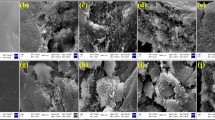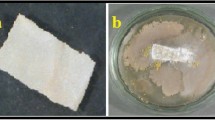Abstract
The natural and synthetic rubber (NR and SR) products are made up of poly-cis-isoprene which are estimated as one of the major solid-wastes and need to be cleared through bacterial bioremediation. The present research reports isolation and characterization of a gram-positive, non-spore forming, filamentous actinomycete Nocardia sp. BSTN01 from the waste of a rubber processing industry. We found NR- and SR-dependent growth of BSTN01 over a period of time. BSTN01 has been found to degrade NR by 55.3% and SR by 45.9% in 6 weeks. We have found an increase in the total protein of BSTN01 cells up to 623.6 and 573.9 µg/ml for NR and SR, respectively, after 6 weeks of growth in rubber-supplemented MSM medium. Scanning electron microscopy revealed adhesive growth of BSTN01 on the surface of NR and SR. Formation of aldehyde groups due to the degradation was indicated by Schiff’s test and confirmed by FTIR-ATR analysis. The genome sequence of BSTN01 revealed the gene responsible for rubber degradation. The presence of lcp gene and structural analysis of the latex clearing protein further confirmed the reliability. Studies on quantification of rubber degradation capability by the isolated strain prove it to be an efficient degrader of NR and SR. This study revealed the genome sequence and structural analysis of the proteins responsible for degradation of rubber. A new fast-growing Nocardia strain can degrade both NR and SR with higher efficiency and have future potential for rubber solid-waste management either alone or in consortia.








Similar content being viewed by others
Data Availability
Not applicable.
Code Availability
Not applicable.
References
Mooibroek, H., & Cornish, K. (2000). Alternative sources of natural rubber. Applied Microbiology and Biotechnology, 53, 355–365.
Luo, Q., Hiessl, S., Poehlein, A., Daniel, R., & Steinbuchel, A. (2014). Insights into the microbial degradation of rubber and gutta-percha by analysis of the complete genome of Nocardia nova SH22a. Applied and Environmental Microbiology, 80(13), 3895–3907.
Natural Rubber Trends Statistics (2020). Association of Natural Rubber Producing Countries. http://www.anrpc.org/html/news-secretariat-details.aspx?ID=9&PID=39&NID=4668
Monthly Rubber Statistical News (2019) The year 2018–19. Statistics & Planning Department Rubber Board, Kottayam-686 002.Kerala, India. Vol. 77. No. 12. http://www.anrpc.org/html/news-secretariatdetails.aspx?ID=9&PID=39&NID=2471
Linos, A. & Steinbüchel, A., (2005). Biodegradation of natural and synthetic rubbers, in: Biopolymers Online. https://doi.org/10.1002/3527600035.bpol2010
Tsuchii, A., & Tokiwa, Y. (2001). Microbial degradation of tire rubber particles. Biotechnology Letters, 23, 963–969.
Zabaniotou, A. A., & Stavropoulos, G. (2003). Pyrolysis of used automobile tires and residual char utilization. Journal of Analytical and Applied Pyrolysis, 70(2), 711–722. https://doi.org/10.1016/S0165-2370(03)00042-1
Luch, A. (2005) The carcinogenic effects of polycyclic aromatic hydrocarbons. Imperial College Press, London, ISBN: 9781860944178, Pages: 489
Air Resources Board, (2005) Report on air emissions from waste tire burning in California. California Environmental Protection Agency, July 1, 2005. http://www.arb.ca.gov/ei/tire/2005_tire_burning_report.pdf.
Asthana, S. R., & Patil, R. K. (2006). Use of alternative fuels in Indian cement industry. Advances in Energy Research, 1, 347–350.
Hassanien, M. A. (2007). Risk assessment of atmospheric toxic pollutants over Cairo. Egypt. Cairo University Journal of Environmental Science, 5, 37–57.
Haines, G., McCulloch, M. & Wong, R. (2010). End-of-life tire management LCA: A comparative analysis for Alberta recycling management authority. The Pembina Institute. http://www.albertarecycling.ca/docs/about-us/lifecycle-assessment-final-report---tires.pdf?Status=Temp&sfvrsn=2
Ziadat, A. H., & Sood, E. (2014). An environmental impact assessment of the open burning of scrap tires. Journal of Applied Science, 14, 2695–2703.
Nayanashree, G., & Thippeswamy, B. (2015). Biodegradation of natural rubber by laccase and manganese peroxidase enzyme of Bacillus subtilis. Environ Process. https://doi.org/10.1007/s40710-015-0118-y
Sarkar, B. & Mandal, S. (2020) Microbial degradation of natural and synthetic rubbers. In: Shah M. (eds) Microbial Bioremediation & Biodegradation. Springer, Singapore. https://doi.org/10.1007/978-981-15-1812-6_21
Heisey, R. M., & Papadatos, S. (1995). Isolation of microorganisms able to metabolize purified natural rubber. Applied and Environmental Microbiology, 61(8), 3092–3097. https://doi.org/10.1128/AEM.61.8.3092-3097.1995
Gallert, C. (2000). Degradation of latex and of natural rubber by Streptomyces strain La 7. Systematic and Applied Microbiology, 23(3), 433–441. https://doi.org/10.1016/S0723-2020(00)80075-2
Linos, A., Berekaa, M. M., Reichelt, R., Keller, U., Schmitt, J., Flemming, H. C., Kroppenstedt, R. M., & Steinbüchel, A. (2000). Biodegradation of cis-1,4-polyisoprene rubbers by distinct actinomycetes: Microbial strategies and detailed surface analysis. Applied and Environmental Microbiology, 66(4), 1639–1645. https://doi.org/10.1128/aem.66.4.1639-1645.2000
Ibrahim, E. M., Arenskötter, M., Luftmann, H., & Steinbüchel, A. (2006). Identification of poly(cis-1,4-Isoprene) degradation intermediates during growth of moderately thermophilic actinomycetes on rubber and cloning of a functional lcp homologue from Nocardia farcinica strain E1. Applied and Environmental Microbiology, 72(5), 3375–3382. https://doi.org/10.1128/AEM.72.5.3375-3382.2006
Watcharakul, S., Umsakul, K., Hodgson, B., Chumeka, W. & Tanrattanakul, V. (2012) Biodegradation of a blended starch/natural rubber foam biopolymer and rubber gloves by Streptomyces coelicolorCH13. Electronic Journal Biotechnology, 15(1). https://doi.org/10.2225/vol15-issue1-fulltext-10
Onyeagoro, G. N., Ohaeri, E., & Timothy, U. J. (2012). Studies on microbial degradation of natural rubber using dilute solution viscosity measurement and weight loss techniques. International Journal of Basic and Applied Science, 1(2), 448–460.
Adzami, N. S., & Tajarudin, H. A. (2018). Biodegradation of natural rubber latex film added with metroxylansagupith form by Bacillus cereus ATCC 14579. Malay Journal of Microbiology, 14, 101–107.
Nawong, C., Umsakul, K., & Sermwittayawong, N. (2018). Rubber gloves biodegradation by a consortium, mixed culture and pure culture isolated from soil. Brazilian Journal of Microbiology, 49(3), 481–488. https://doi.org/10.1016/j.bjm.2017.07.006
Kasai, D. (2020). Poly(cis-1,4-isoprene)-cleavage enzymes from natural rubber-utilizing bacteria. Bioscience Biotechnology and Biochemistry, 84, 1089–1097. https://doi.org/10.1080/09168451.2020.1733927
Jendrossek, D., Tomasi, G., & Kroppenstedt, R. M. (1997). Bacterial degradation of natural rubber: A privilege of actinomycetes? FEMS Microbiology Letters, 150, 179–188.
Basik, A. A., Sanglier, J. J., Yeo, C. T., & Sudesh, K. (2021). Microbial degradation of rubber: Actinobacteria. Polymers, 13(12), 1989. https://doi.org/10.3390/polym13121989
Le, T. N., Mikolasch, A., Awe, S., Sheikhany, H., Klenk, H. P., & Schauer, F. (2010). Oxidation of aliphatic, branched chain, and aromatic hydrocarbons by Nocardia cyriacigeorgica isolated from oil-polluted sand samples collected in the Saudi Arabian Desert. Journal of basic microbiology, 50(3), 241–253. https://doi.org/10.1002/jobm.200900358
Azadi, D., & Shojaei, H. (2020). Biodegradation of polycyclic aromatic hydrocarbons, phenol and sodium sulfate by Nocardia species isolated and characterized from Iranian ecosystems. Scientific Reports, 10, 21860. https://doi.org/10.1038/s41598-020-78821-1
Warneke, S., Arenskötter, M., Tenberge, K. B., & Steinbüchel, A. (2007). Bacterial degradation of poly(trans-1,4-isoprene) (gutta percha). Microbiology (Reading, England), 153(Pt 2), 347–356. https://doi.org/10.1099/mic.0.2006/000109-0
Berekaa, M. M. (2006). Colonization and microbial degradation of polyisoprene rubber by nocardiaform actinomycete Nocardia sp. strain-MBR. Biotechnology, 5, 234–239.
Shah, A. A., Hasan, F., Shah, Z., & Kanwal, N. (2013). Biodegradation of natural and synthetic rubbers: A review. International Biodeterioration and Biodegradation, 83, 145–157. https://doi.org/10.1016/j.ibiod.2013.05.004
Williams, S. T., & Davies, F. L. (1967). Use of scanning electron microscope for the examination of actinomycetes. Journal of General Microbiology, 48(2), 171–177. https://doi.org/10.1099/00221287-48-2-171
Yoon, S. H., Ha, S. M., Kwon, S., Lim, J., Kim, Y., Seo, H., & Chun, J. (2017). Introducing EzBioCloud: A taxonomically united database of 16S rRNA gene sequences and whole-genome assemblies. International Journal of Systematic and Evolutionary Microbiology, 67(5), 1613–1617.
Saitou, N., & Nei, M. (1987). The neighbor-joining method: A new method for reconstructing phylogenetic trees. Molecular Biology and Evoluion, 4(4), 406–425. https://doi.org/10.1093/oxfordjournals.molbev.a040454
Kumar, S., Stecher, G., Li, M., Knyaz, C., & Tamura, K. (2018). MEGA X: Molecular evolutionary genetics analysis across computing platforms. Molecular biology and evolution, 35(6), 1547–1549. https://doi.org/10.1093/molbev/msy096
Kimura, M. (1980). A simple method for estimating evolutionary rates of base substitutions through comparative studies of nucleotide sequences. Journal of Molecular Evolution, 16(2), 111–120. https://doi.org/10.1007/BF01731581
Aziz, R. K., Bartels, D., Best, A. A., DeJongh, M., Disz, T., Edwards, R. A., et al. (2008). The RAST Server: Rapid annotations using subsystems technology. BMC Genomics, 9, 75. https://doi.org/10.1186/1471-2164-9-75
Sippl, M. J. (1993). Recognition of errors in three-dimensional structures of proteins. Proteins, 17, 355–362.
Wiederstein, M., & Sippl, M. J. (2007). ProSA-web: Interactive web service for the recognition of errors in three-dimensional structures of proteins. Nucleic Acid Research, 35, W407–W410.
Hapuarachchi, S. N. S., Kariyapper, S. R., Gunawardana, M. B. D. M. D., Egodage, S., & Ariyadasa, T. U. (2016). Biodegradation of natural rubber latex by a novel bacterial species isolated from soil. Moratuwa Engineering Research Conference (MERCon), 2016, 293–296. https://doi.org/10.1109/MERCon.2016.7480156
Danna, C. S., Cavalcante, D. G. S. M., Gomes, A. S., Kerche-Silva, L., Yoshihara, E., Osorio-Roman, I. O., Salmazo, L. O., Rodriguez-Perez, M. A., Aroca, R. F., & Job, A. E. (2016). Silver nanoparticles embedded in natural rubber films: Synthesis, characterization, and evaluation of in vitro toxicity. Journal of Nanomaterials, 2016, 2368630. https://doi.org/10.1155/2016/2368630
Vivod, R., Oetermann, S., Hiessl, S., Gutsche, S., Remmers, N., Meinert, C., Voigt, B., Riedel, K., & Steinbüchel, A. (2017). Oligo(cis-1,4-isoprene) aldehyde-oxidizing dehydrogenases of the rubber-degrading bacterium Gordonia polyisoprenivorans VH2. Applied Microbiology and Biotechnology, 101(21), 7945–7960. https://doi.org/10.1007/s00253-017-8508-x
Bröker, D., Dietz, D., Arenskötter, M., & Steinbüchel, A. (2008). The genomes of the non-clearing-zone-forming and natural-rubber-degrading species Gordonia polyisoprenivorans and Gordonia westfalica harbor genes expressing Lcp activity in Streptomyces strains. Applied and Environmental Microbiology, 74(8), 2288–2297. https://doi.org/10.1128/AEM.02145-07
Watcharakul, S., Röther, W., Birke, J., Umsakul, K., Hodgson, B., & Jendrossek, D. (2016). Biochemical and spectroscopic characterization of purified Latex Clearing Protein (Lcp) from newly isolated rubber degrading Rhodococcus rhodochrous strain RPK1 reveals novel properties of Lcp. BMC Microbiology, 16, 92. https://doi.org/10.1186/s12866-016-0703-x
Ilcu, L., Röther, W., Birke, J., Brausemann, A., Einsle, O., & Jendrossek, D. (2017). Structural and functional analysis of latex clearing protein (Lcp) provides insight into the enzymatic cleavage of rubber. Scientific Reports, 7, 6179. https://doi.org/10.1038/s41598-017-05268-2
Vivod, R., Andler, R., Oetermann, S., Altenhoff, A. L., Seipel, N., Holtkamp, M., Hogeback, J., Karst, U., & Steinbüchel, A. (2020). Characterization of the latex clearing protein of the poly(cis-1,4-isoprene) and poly(trans-1,4-isoprene) degrading bacterium Nocardia nova SH22a. Journal of General and Applied Microbiology, 65(6), 293–300. https://doi.org/10.2323/jgam.2019.01.003
Linh, D. V., Huong, N. L., Tabata, M., Imai, S., Iijima, S., Kasai, D., Anh, T. K., & Fukuda, M. (2017). Characterization and functional expression of a rubber degradation gene of a Nocardia degrader from a rubber-processing factory. Journal of Bioscience and Bioengineering, 123(4), 412–418. https://doi.org/10.1016/j.jbiosc.2016.11.012
Birke, J., & Jendrossek, D. (2019). Solimonas fluminis has an active latex-clearing protein. Applied Microbiology and Biotechnology, 103(19), 8229–8239. https://doi.org/10.1007/s00253-019-10085-w
Sievers, F., Wilm, A., Dineen, D., Gibson, T. J., Karplus, K., Li, W., Lopez, R., McWilliam, H., Remmert, M., Söding, J., Thompson, J. D., & Higgins, D. G. (2011). Fast, scalable generation of high-quality protein multiple sequence alignments using Clustal Omega. Molecular System Biology, 7, 539. https://doi.org/10.1038/msb.2011.75
Wilson, J. W. (2012). Nocardiosis: Updates and clinical overview. Mayo Clinic proceedings, 87(4), 403–407. https://doi.org/10.1016/j.mayocp.2011.11.016
Al Akhrass, F., Hachem, R., Mohamed, J. A., Tarrand, J., Kontoyiannis, D. P., Chandra, J., Ghannoum, M., Haydoura, S., Chaftari, A. M., & Raad, I. (2011). Central venous catheter-associated Nocardia bacteremia in cancer patients. Emergence in Infectious Disease, 17(9), 1651–1658. https://doi.org/10.3201/eid1709.101810
Tsuchii, A., Suzuki, T., & Takeda, K. (1985). Microbial DEGRADATION OF NATURAL RUBBER VULCANIZATES. Applied and Environmental Microbiology, 50, 965–970.
Acknowledgements
BS is thankful to University of Calcutta for his fellowship. We are especially thankful to Dr. Prithidipa Sahoo, Department of Chemistry, Visva-Bharati University, for her generous help to interpret FTIR data and proofreading the manuscript.
Author information
Authors and Affiliations
Contributions
BS designed and performed the experiment and wrote the main manuscript text; AGM helped in acquisition and analysing the in silico data; MPS helped in editing the draft; SM conceptualized the research, designed the experiments and critically revised the manuscript.
Corresponding author
Ethics declarations
Ethics Approval
Not applicable.
Consent to Participate
Not applicable.
Consent for Publication
The authors have consent to publish the manuscript in this journal.
Conflict of Interest
The authors declare no competing interests.
Additional information
Publisher's Note
Springer Nature remains neutral with regard to jurisdictional claims in published maps and institutional affiliations.
Supplementary Information
Below is the link to the electronic supplementary material.
Rights and permissions
About this article
Cite this article
Sarkar, B., Gupta, A.M., Shah, M.P. et al. Poly-cis-isoprene Degradation by Nocardia sp. BSTN01 Isolated from Industrial Waste. Appl Biochem Biotechnol 194, 3333–3350 (2022). https://doi.org/10.1007/s12010-022-03854-3
Received:
Accepted:
Published:
Issue Date:
DOI: https://doi.org/10.1007/s12010-022-03854-3




